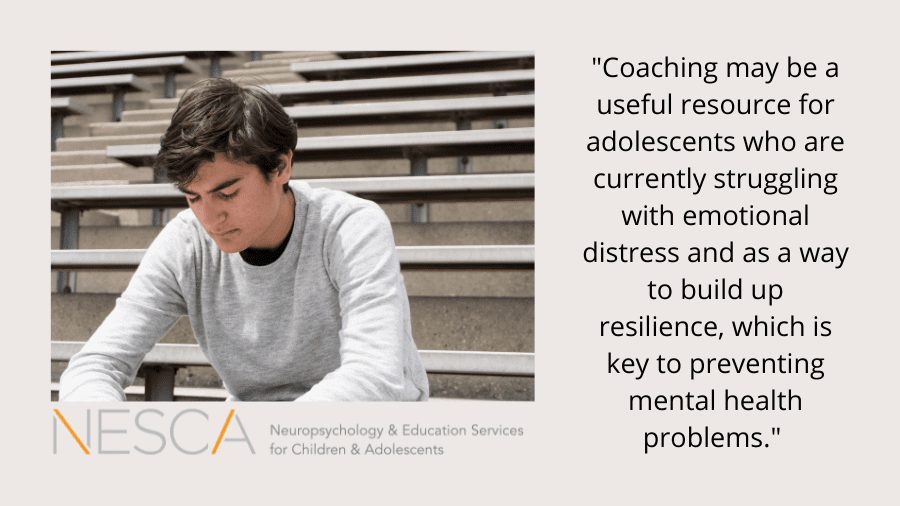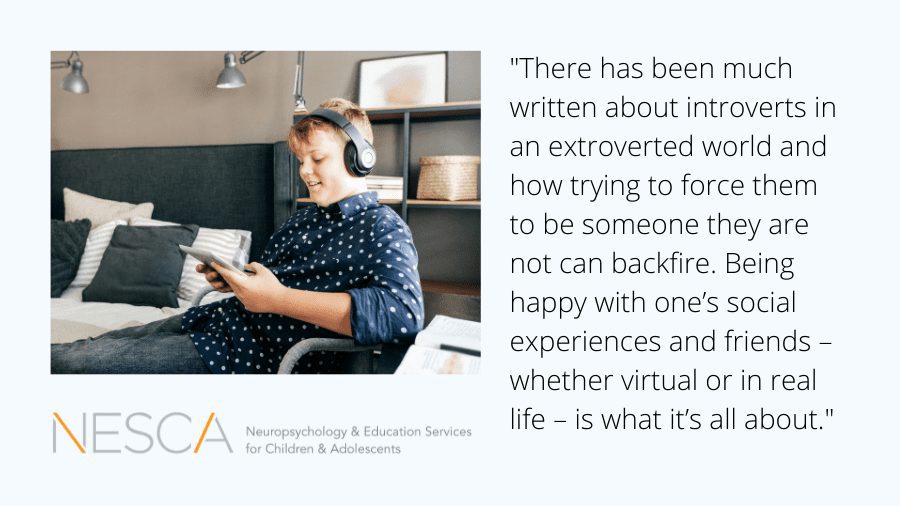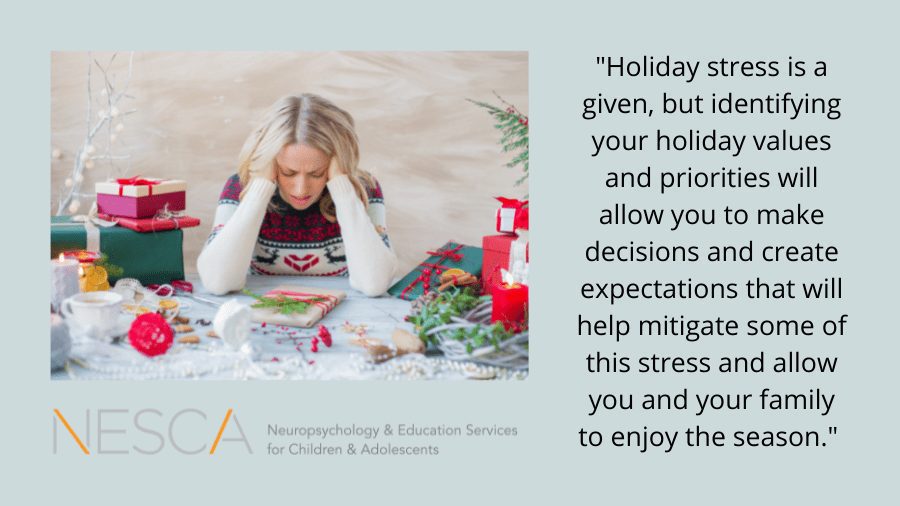
 By: Ann Helmus, Ph.D.
By: Ann Helmus, Ph.D.
NESCA Founder/Director; Clinical Neuropsychologist
Liam’s mother was distraught, “He’s always in his room. He doesn’t want to see his friends. We’re so worried; something is wrong!”
The last time I saw Liam, he was a popular, gregarious ninth grader, a varsity athlete who struggled to focus on schoolwork. Now in college, Liam explained, “Covid ruined everything,” lamenting that he missed prom with his girlfriend, the senior trip, and his graduation ceremony and parties – events he eagerly anticipated throughout high school, irretrievably gone from his life. My evaluation indicated that Liam had developed severe social anxiety; in social situations, he experienced acute anxiety, second-guessing everything he did and said and experiencing physiologic symptoms. He was also depressed – a radical change from the vibrant, outgoing young man of several years ago.
Liam is typical of the many adolescents struggling with anxiety and depression borne of the pandemic, characterized as a crisis in a recent report by U.S. Surgeon General Vivek H. Murthy because of the hugely increased incidence of mental disorders in youth and adolescents, coupled with the lack of availability of treatment. The American Psychological Association reports that waiting lists and referrals for child psychologists have more than doubled since the pandemic started.
Although my training in psychology dictated psychotherapy and/or psychiatric intervention as the appropriate treatment for Liam’s anxiety and depressed mood, these services would not be available for many months. While he was on waiting lists, I suggested that Liam work with a health and life coach at NESCA so that he would at least have someone to talk with about his concerns.
The coaching began with an exploration of the question, “Who do you want to be?” Liam enthusiastically painted a picture of his former self – social, athletic, and a successful student. He and the coach then identified the obstacles in his path to this vision and began tackling them one by one. Small successes and changes quickly led to larger ones. After only six sessions, Liam is well on his way to reclaiming his former self and is feeling much less anxious and depressed. He has resumed going to the gym and is cleaning up his diet. He is socializing more comfortably with peers. There is still work to be done, but he has embraced the coaching approach, which is based on building strengths, and he will likely not need additional mental health services when his name comes up on the wait lists.
Life coaching is a structured, supportive approach to helping individuals make changes, reach goals and develop resiliency by working at all levels on the interactive triangle of thoughts, feelings, and actions; improving any one of these components positively impacts the others. Coaching may be a useful resource for adolescents who are currently struggling with emotional distress and as a way to build up resilience, which is key to preventing mental health problems.
To learn more about Health & Life Coaching at NESCA, complete our online Intake Form or contact Billy Demiri at: bdemiri@nesca-newton.com.
While coaching can be a tool to address the needs of some individuals, it may not be appropriate for others, particularly those with profound mental health needs or who are in a crisis. The intake process will determine whether coaching should be used with an individual.
About the Author
NESCA Founder/Director Ann Helmus, Ph.D. is a licensed clinical  neuropsychologist who has been practicing for almost 20 years. In 1996, she jointly founded the Children’s Evaluation Center (CEC) in Newton, Massachusetts, serving as co-director there for almost ten years. During that time, CEC emerged as a leading regional center for the diagnosis and remediation of both learning disabilities and Autism Spectrum Disorders.
neuropsychologist who has been practicing for almost 20 years. In 1996, she jointly founded the Children’s Evaluation Center (CEC) in Newton, Massachusetts, serving as co-director there for almost ten years. During that time, CEC emerged as a leading regional center for the diagnosis and remediation of both learning disabilities and Autism Spectrum Disorders.
In September of 2007, Dr. Helmus established NESCA (Neuropsychology & Education Services for Children & Adolescents), a client and family-centered group of seasoned neuropsychologists and allied staff, many of whom she trained, striving to create and refine innovative clinical protocols and dedicated to setting new standards of care in the field.
Dr. Helmus specializes in the evaluation of children with learning disabilities, attention and executive function deficits and primary neurological disorders. In addition to assessing children, she also provides consultation and training to both public and private school systems. She frequently makes presentations to groups of parents, particularly on the topics of non-verbal learning disability and executive functioning.
To book an evaluation with Dr. Helmus, NESCA Founder and Director, or one of our many other expert neuropsychologists or therapists, complete NESCA’s online intake form.
Neuropsychology & Education Services for Children & Adolescents (NESCA) is a pediatric neuropsychology practice and integrative treatment center with offices in Newton and Plainville, Massachusetts, as well as Londonderry, New Hampshire. NESCA serves clients from preschool through young adulthood and their families. For more information, please email info@nesca-newton.com or call 617-658-9800.





 and academia for over 30 years. She is a national consultant and speaker on program design and the inclusion of children and adolescents with special needs, especially those diagnosed with Autism Spectrum Disorder (ASD). Prior to joining NESCA, Ms. Lucci was the Principal of the Partners Program/EDCO Collaborative and previously the Program Director and Director of Consultation at MGH/Aspire for 13 years, where she built child, teen and young adult programs and established the 3-Ss (self-awareness, social competency and stress management) as the programming backbone. She also served as director of the Autism Support Center. Ms. Lucci was previously an elementary classroom teacher, special educator, researcher, school psychologist, college professor and director of public schools, a private special education school and an education collaborative.
and academia for over 30 years. She is a national consultant and speaker on program design and the inclusion of children and adolescents with special needs, especially those diagnosed with Autism Spectrum Disorder (ASD). Prior to joining NESCA, Ms. Lucci was the Principal of the Partners Program/EDCO Collaborative and previously the Program Director and Director of Consultation at MGH/Aspire for 13 years, where she built child, teen and young adult programs and established the 3-Ss (self-awareness, social competency and stress management) as the programming backbone. She also served as director of the Autism Support Center. Ms. Lucci was previously an elementary classroom teacher, special educator, researcher, school psychologist, college professor and director of public schools, a private special education school and an education collaborative.
 Londonderry, NH office. She specializes in the evaluation of anxious children and teens, working to tease apart the various factors lending to their stress, such as underlying learning, attentional, or emotional challenges. She particularly enjoys working with the seemingly “unmotivated” child, as well as children who have “flown under the radar” for years due to their desire to succeed.
Londonderry, NH office. She specializes in the evaluation of anxious children and teens, working to tease apart the various factors lending to their stress, such as underlying learning, attentional, or emotional challenges. She particularly enjoys working with the seemingly “unmotivated” child, as well as children who have “flown under the radar” for years due to their desire to succeed.








 By
By  complex, inter-related needs, with a particular emphasis on identifying co-occurring neurodevelopmental and psychiatric challenges. She specializes in the evaluation of developmental disabilities including autism spectrum disorder and social-emotional difficulties stemming from mood, anxiety, attachment and trauma-related diagnoses. She often assesses children who have “unique learning styles” that can underlie deficits in problem-solving, emotion regulation, social skills and self-esteem.
complex, inter-related needs, with a particular emphasis on identifying co-occurring neurodevelopmental and psychiatric challenges. She specializes in the evaluation of developmental disabilities including autism spectrum disorder and social-emotional difficulties stemming from mood, anxiety, attachment and trauma-related diagnoses. She often assesses children who have “unique learning styles” that can underlie deficits in problem-solving, emotion regulation, social skills and self-esteem.





Connect with Us